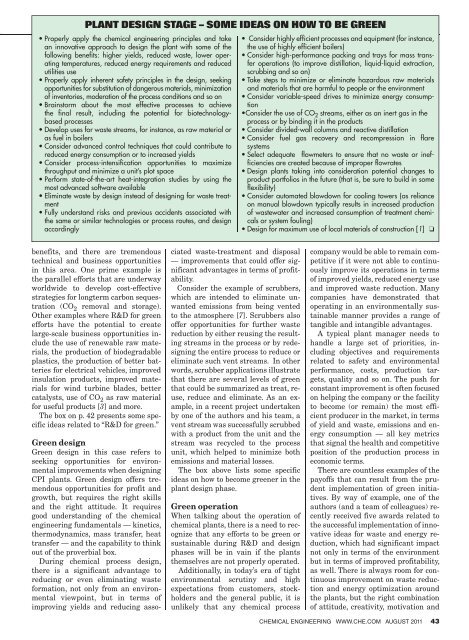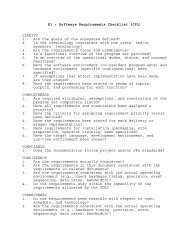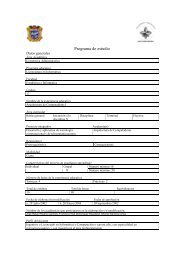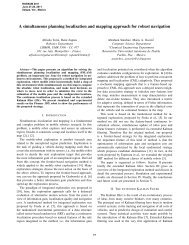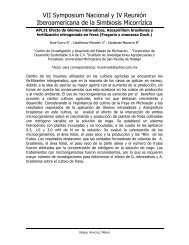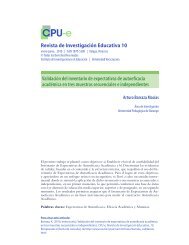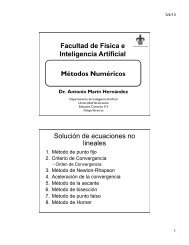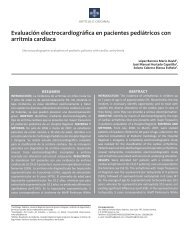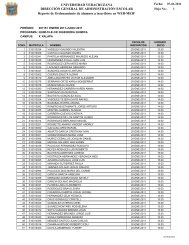Understanding the Software Options
Understanding the Software Options
Understanding the Software Options
Create successful ePaper yourself
Turn your PDF publications into a flip-book with our unique Google optimized e-Paper software.
PLANT DESIGN STAGE – SOME IDEAS ON HOW TO BE GREEN<br />
• Properly apply <strong>the</strong> chemical engineering principles and take<br />
an innovative approach to design <strong>the</strong> plant with some of <strong>the</strong><br />
following benefits: higher yields, reduced waste, lower operating<br />
temperatures, reduced energy requirements and reduced<br />
utilities use<br />
• Properly apply inherent safety principles in <strong>the</strong> design, seeking<br />
opportunities for substitution of dangerous materials, minimization<br />
of inventories, moderation of <strong>the</strong> process conditions and so on<br />
• Brainstorm about <strong>the</strong> most effective processes to achieve<br />
<strong>the</strong> final result, including <strong>the</strong> potential for biotechnologybased<br />
processes<br />
• Develop uses for waste streams, for instance, as raw material or<br />
as fuel in boilers<br />
• Consider advanced control techniques that could contribute to<br />
reduced energy consumption or to increased yields<br />
• Consider process-intensification opportunities to maximize<br />
throughput and minimize a unit’s plot space<br />
• Perform state-of-<strong>the</strong>-art heat-integration studies by using <strong>the</strong><br />
most advanced software available<br />
• Eliminate waste by design instead of designing for waste treatment<br />
• Fully understand risks and previous accidents associated with<br />
<strong>the</strong> same or similar technologies or process routes, and design<br />
accordingly<br />
benefits, and <strong>the</strong>re are tremendous<br />
technical and business opportunities<br />
in this area. One prime example is<br />
<strong>the</strong> parallel efforts that are underway<br />
worldwide to develop cost-effective<br />
strategies for longterm carbon sequestration<br />
(CO 2 removal and storage).<br />
O<strong>the</strong>r examples where R&D for green<br />
efforts have <strong>the</strong> potential to create<br />
large-scale business opportunities include<br />
<strong>the</strong> use of renewable raw materials,<br />
<strong>the</strong> production of biodegradable<br />
plastics, <strong>the</strong> production of better batteries<br />
for electrical vehicles, improved<br />
insulation products, improved materials<br />
for wind turbine blades, better<br />
catalysts, use of CO 2 as raw material<br />
for useful products [3] and more.<br />
The box on p. 42 presents some specific<br />
ideas related to “R&D for green.”<br />
Green design<br />
Green design in this case refers to<br />
seeking opportunities for environmental<br />
improvements when designing<br />
CPI plants. Green design offers tremendous<br />
opportunities for profit and<br />
growth, but requires <strong>the</strong> right skills<br />
and <strong>the</strong> right attitude. It requires<br />
good understanding of <strong>the</strong> chemical<br />
engineering fundamentals — kinetics,<br />
<strong>the</strong>rmodynamics, mass transfer, heat<br />
transfer — and <strong>the</strong> capability to think<br />
out of <strong>the</strong> proverbial box.<br />
During chemical process design,<br />
<strong>the</strong>re is a significant advantage to<br />
reducing or even eliminating waste<br />
formation, not only from an environmental<br />
viewpoint, but in terms of<br />
improving yields and reducing asso-<br />
ciated waste-treatment and disposal<br />
— improvements that could offer significant<br />
advantages in terms of profitability.<br />
Consider <strong>the</strong> example of scrubbers,<br />
which are intended to eliminate unwanted<br />
emissions from being vented<br />
to <strong>the</strong> atmosphere [7]. Scrubbers also<br />
offer opportunities for fur<strong>the</strong>r waste<br />
reduction by ei<strong>the</strong>r reusing <strong>the</strong> resulting<br />
streams in <strong>the</strong> process or by redesigning<br />
<strong>the</strong> entire process to reduce or<br />
eliminate such vent streams. In o<strong>the</strong>r<br />
words, scrubber applications illustrate<br />
that <strong>the</strong>re are several levels of green<br />
that could be summarized as treat, reuse,<br />
reduce and eliminate. As an example,<br />
in a recent project undertaken<br />
by one of <strong>the</strong> authors and his team, a<br />
vent stream was successfully scrubbed<br />
with a product from <strong>the</strong> unit and <strong>the</strong><br />
stream was recycled to <strong>the</strong> process<br />
unit, which helped to minimize both<br />
emissions and material losses.<br />
The box above lists some specific<br />
ideas on how to become greener in <strong>the</strong><br />
plant design phase.<br />
Green operation<br />
When talking about <strong>the</strong> operation of<br />
chemical plants, <strong>the</strong>re is a need to recognize<br />
that any efforts to be green or<br />
sustainable during R&D and design<br />
phases will be in vain if <strong>the</strong> plants<br />
<strong>the</strong>mselves are not properly operated.<br />
Additionally, in today’s era of tight<br />
environmental scrutiny and high<br />
expectations from customers, stockholders<br />
and <strong>the</strong> general public, it is<br />
unlikely that any chemical process<br />
• Consider highly efficient processes and equipment (for instance,<br />
<strong>the</strong> use of highly efficient boilers)<br />
• Consider high-performance packing and trays for mass transfer<br />
operations (to improve distillation, liquid-liquid extraction,<br />
scrubbing and so on)<br />
• Take steps to minimize or eliminate hazardous raw materials<br />
and materials that are harmful to people or <strong>the</strong> environment<br />
• Consider variable-speed drives to minimize energy consumption<br />
•Consider <strong>the</strong> use of CO 2 streams, ei<strong>the</strong>r as an inert gas in <strong>the</strong><br />
process or by binding it in <strong>the</strong> products<br />
• Consider divided-wall columns and reactive distillation<br />
• Consider fuel gas recovery and recompression in flare<br />
systems<br />
• Select adequate flowmeters to ensure that no waste or inefficiencies<br />
are created because of improper flowrates<br />
• Design plants taking into consideration potential changes to<br />
product portfolios in <strong>the</strong> future (that is, be sure to build in some<br />
flexibility)<br />
• Consider automated blowdown for cooling towers (as reliance<br />
on manual blowdown typically results in increased production<br />
of wastewater and increased consumption of treatment chemicals<br />
or system fouling)<br />
• Design for maximum use of local materials of construction [1] ❏<br />
company would be able to remain competitive<br />
if it were not able to continuously<br />
improve its operations in terms<br />
of improved yields, reduced energy use<br />
and improved waste reduction. Many<br />
companies have demonstrated that<br />
operating in an environmentally sustainable<br />
manner provides a range of<br />
tangible and intangible advantages.<br />
A typical plant manager needs to<br />
handle a large set of priorities, including<br />
objectives and requirements<br />
related to safety and environmental<br />
performance, costs, production targets,<br />
quality and so on. The push for<br />
constant improvement is often focused<br />
on helping <strong>the</strong> company or <strong>the</strong> facility<br />
to become (or remain) <strong>the</strong> most efficient<br />
producer in <strong>the</strong> market, in terms<br />
of yield and waste, emissions and energy<br />
consumption — all key metrics<br />
that signal <strong>the</strong> health and competitive<br />
position of <strong>the</strong> production process in<br />
economic terms.<br />
There are countless examples of <strong>the</strong><br />
payoffs that can result from <strong>the</strong> prudent<br />
implementation of green initiatives.<br />
By way of example, one of <strong>the</strong><br />
authors (and a team of colleagues) recently<br />
received five awards related to<br />
<strong>the</strong> successful implementation of innovative<br />
ideas for waste and energy reduction,<br />
which had significant impact<br />
not only in terms of <strong>the</strong> environment<br />
but in terms of improved profitability,<br />
as well. There is always room for continuous<br />
improvement on waste reduction<br />
and energy optimization around<br />
<strong>the</strong> plants, but <strong>the</strong> right combination<br />
of attitude, creativity, motivation and<br />
CHEMICAL ENGINEERING WWW.CHE.COM AUGUST 2011 43


